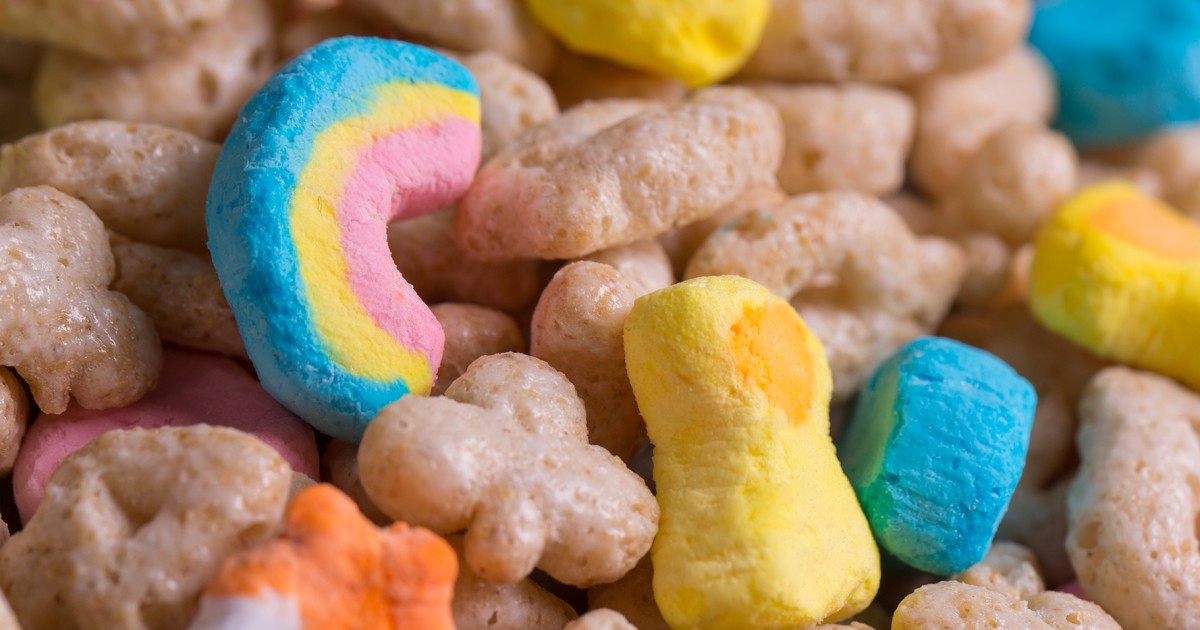The proposed legislation would prohibit school cafeterias from serving foods with Red 40 and six other chemicals associated with potential health and behavioral issues.
A state legislator introduced a first-of-its-kind bill Tuesday that would ban seven additives from the foods that are served in California’s public schools.
Assembly Bill 2316 would prohibit school cafeterias from offering foods containing six artificial food dyes that have been linked to hyperactivity and behavioral issues in some children. It would also outlaw titanium dioxide, a whitening agent used in candies and other products that is banned by the European Union because of concerns that it is potentially genotoxic, meaning it may damage DNA and cause cancer.
The bill, which was first shared with NBC News, would affect certain cereals, condiments and baked goods, among other foods, and it would make California the first state to ban the additives from schools. It was introduced by Democratic Assemblymember Jesse Gabriel.
Ok I know I’m going to get ripped for this one, but I have a sincere question. I don’t understand how a food dye can create behavioral problems. What chemicals are in red 40, and how are they directly linked to behavior, not just through correlation? Like is there actually proof of this that we’re ignoring? Because I only hear really crunchy moms talk about this, and I take their opinions on diet with a Boulder of salt.
Just remove the notion that “it’s just a dye” from the argument and change it to “unnecessary substance added to food for aesthetic purposes” which may potentially have unintended impacts on the body.
I don’t care for the pseudoscience of it but the idea that we ought to remove fillers and shit from food we feed kids isn’t terrible on that merit alone.
That said we just had a huge issue over lead in cinnamon from a product used to add color, so right there is a perfect example of a scenario where a food colorant could lead to permanent cognitive impairment.
’tThat said we just had a huge issue over lead in cinnamon from a product used to add color, so right there is a perfect example of a scenario where a food colorant could lead to permanent cognitive impairment.
This is the equivalent of banning spinach because of a salmonella outbreak (which kills more ppl). This seems more like an overreaction from those ppl fearful of any compound that isn’t “natural” or substance they can’t pronounce.
I looked this up a little while ago because a student had a note in their file that they are to avoid red 40 due to behavioral changes. I think what I gathered is that there is maybe some evidence but nothing has been researched thoroughly to make any real determination. Here’s the conclusion of a study: “ Conclusions: A restriction diet benefits some children with ADHD. Effects of food colors were notable were but susceptible to publication bias or were derived from small, nongeneralizable samples. Renewed investigation of diet and ADHD is warranted.” https://pubmed.ncbi.nlm.nih.gov/22176942/
Imagine if LSD was a vibrant color. Obviously not a good choice for food dye. Not just because it’s colorless and odorless but a very small amount changes behavior drastically. There are thousands of psychoactive substances, natural and synthetic.
One of the kids I used to babysit, his mom discovered a link between artificial color and behavior problems about 25 years ago from Go-Gurt. Easy process of elimination from trying other yogurts that it’s not the sugar or the yogurt. Anyway this kids behavior and life was a lot easier without food dyes. If I recall he was the only one of the 4 kids that it was so noticeable.
The dye is derived from coal tar. Granted that is not its final form, but I can see where the crunchy moms you describe have some reservations. I can understand the preference for a dye that is derived from a source that is not a known carcinogen to rule out any ambiguity in the refinement process.
https://www.chemeurope.com/en/encyclopedia/Allura_Red_AC.html
Physiology is a very complicated subject and not one I would trust randos on an internet forum to understand.
I’m curious to see what food looks like without any dyes at all. See how many foods have natural colors we exploit or how grey and brown food becomes.
I think the real shocker to most people will be the inconsistency. You can have two things side by side that are identical in every way except for color. One is going to sell and one won’t. Or they could both not sell even. That’s how all this coloring got started to begin with.
It’s funny whenever I cook from “scratch” how often my dishes end up “reddish orangish brown”
Honestly there’s something about that color that is so very appetizing to me but I know puts others off.
I mean, if you eat normal foods then none of it should have any dyes.
Farmed salmon is usually dyed.
“Normal”. So just cut out anything you didn’t make yourself from scratch at home. Ok, pal. That’ll fly with the majority of working households.
Also you can no longer buy many condiments or some spices. Or ever eat out again. So good luck with all your increased labor.
Grey and brown.
Considering the shit quality level of foods served in school cafeterias in the country where pizza was declared a vegetable for school lunch purposes, this probably shouldn’t be the highest priority.
Luckily we are able to do multiple things at once!
Increasing food quality in general would also have the side effect of reducing additives, but without targeting specific ones claimed to be harmful without evidence.
And if you banned red 40 specifically, it might be replaced with something organic like beet juice, or it might be replaced with a newer synthetic additive that’s been studied even less.
a newer synthetic additive that’s been studied even less.
Look as long as it’s BPA free
Politically? Are we?
No we can’t. We have ADHD \o/
/s
Why only at schools?
Good.
too bad its not red 21. 21. Whats 9+10? 21.











